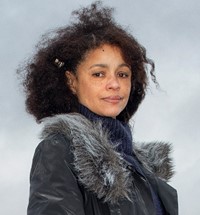Clare Weze


About Author
Clare Weze was raised in London and Yorkshire and has British and Nigerian heritage. She writes for adults and children and has always written around her day job, starting out as a hairdresser in London’s West End, then moving on to a science degree, postgraduate studies and work in the fields of biomedical and environmental research. The Lightning Catcher is her debut novel for children.
Find out more at www.clareweze.com or on Twitter @ClareWeze
Interview
The Storm Swimmer (Bloomsbury Children's Books)
January 2023
Clare Weze's The Storm Swimmer weaves science into a real life adventure story. When Ginika is sent to live with her grandparents one summer, she has no idea of the life-changing adventures and friendships she is about to discover. Here, Clare Weze talks about what inspired this story of friendship, family and inclusion.
Q&A with Clare Weze
1. Can you tell us how you started writing for children and young people, and what kinds of books you enjoy writing?
I started writing when I was a child, so it was probably inevitable, as those were the books I was reading. As an adult, I continued in the genre that felt most natural, then began writing for adults too, and I've written for both ever since.
I love children's books, and still read them for pleasure. I also enjoy writing speculative fiction, and fiction that explores relationships, misunderstandings and mistakes that people have to try to unravel.
2. What happens in your new book, The Storm Swimmer?
My character Ginika's life gets turned upside down and inside out when she loses her home. Her parents send her to live with her grandparents in their seaside boarding house while they try to sort out the mess their lives have become. They want her out of harm's way, but Ginika feels abandoned, and misses her friends. She has no real friends in the seaside town apart from Scarlett, who is a tricky, tricky person.
However, one day she sees a boy who appears to live in the sea, and her burning ambition is now to meet him and find out if that's true.
3. What inspired this story?
I was on a beach, actually. There's a place in Cumbria called Silecroft with miles and miles of sand and stones, and it's just wild and idyllic. The opening of a story for adults came to me in a flash, and it involved a man who was walking right beside me and annoying a woman, his friend. What if, I thought, he simply flipped into the water when her back was turned? What if his legs became a tail when they hit the water? He'd come from the sea all along, and she just didn't know it.
I worked it up into a short story, then realised what a good children's book it would make, and wrote the beginning again with new characters. I changed my mind about the fish tail and certain other aspects. I wanted to get away from the mythological and into the biological.
4. There are similar threads in your debut book, The Lightning Catcher, which also features storms and lightning. What draws you to this in your writing?
I didn't set out to make storms a feature of The Storm Swimmer - the title was a later, joint decision with my editor (my working title was Boy from the Sea). As I explored the setting and characters, storms seemed to be a natural consequence of the direction of travel! I've loved dramatic weather all my life. I think it makes me feel closer to nature.
5. What are the main challenges that Ginika faces at the start of the book?
She's frightened about what her parents aren't telling her, and imagines all kinds of trouble. They've been evicted from their home, which can be terrifying, and she feels abandoned. It's between the end of primary school and the beginning of secondary, which can be a difficult time not to have familiar friends around. She suspects - rightly as it turns out - that best friend Alisha will drift away if she isn't there, and she'll lose many of her most precious connections. And of course, the seaside town isn't nearly as diverse as London, although that isn't explicitly focused on in the book.
6. How did you go about deciding what the 'storm swimmers' in the story - Peri and his family - would be like?
I researched marine mammals, especially the evolution of whales, and built up an idea of how the sea people's bodies might have adapted to marine life. It was fascinating. I decided they would deal with salt in the same way as marine birds and sea turtles, which have salt glands, because Peri's salty white tears made such a striking visual image.
I went through their bodies in this way, studying this adaptation and that form, and the behaviours that would be necessary to survive in the water, such as being very strong and not hanging around anywhere for too long. ABBA's song Move On was hugely inspirational for this part!
7. How hard was it to keep The Storm Swimmer 'real' while introducing this fantasy element to the story?
It was surprisingly easy, probably because of my background. I've studied evolutionary biology, so I'm always aware that all our forms are only the result of a twist of circumstance. It could all have been so different.
8. You explore a number of questions around friendship and family in the book - what would you like your readers to take from Ginika's experiences?
There are so many possible takes, depending on the individual reader, that I don't like to tie the book down to just a few. Some readers will have been in similar situations. The main takeaway I got when writing the book is that the best of intentions can still impact the person having to live with our decisions. Ginika's parents did their best in choosing a safe and loving temporary home for her, but she still felt abandoned and transplanted. I felt the same way when I went to live with my grandparents for different reasons. As a parent, I've learned that children can interpret and experience events in different ways, and that parental good will isn't always enough to cushion those experiences.
Another thread in the book that I hope piques readers' interest is the idea of what we most want, and the ways in which this can clash with what we need, and that both aspects can change over time. Ginika and Peri are two kids with strong ‘wants'. Ginika wants to go back to London and get her old life back. Peri wants to taste the strength of light, and try out the still life of land. Both change their minds about these desires during the story.
9. Through the children Ginika, Ted and Peri, you also explore questions about representation and inclusion. How important is this to you as a writer?
It's very important. I don't like leaving people out of books just because their life experience is different to mine. A wonderful sensitivity reader helped me with Ted's disability, because although I've been adjacent to disability through family members, I haven't experienced it first-hand. In terms of diversity, it's vital for children to read about the kinds of people who do actually live in this world, and we aren't all the same colour, shape or size.
10. What are your favourite times of day, and places, to write?
I don't often get the chance to write in cafés these days, but I love the feeling of being surrounded by people yet dipping in and out of my own totally different world on the page. Mornings are nice because of the special light, but I also like writing in the evenings, when all interruptions have gone away.
When you're not writing....
What is your favourite season, and seasonal activity?
Summer, swimming
What would a 'best ever' day away from your desk and notebook look like?
Because I'm a Londoner who hasn't lived there for a long time, my best ever day would begin with a walk from somewhere like Clerkenwell, going through to Regents Park, and stopping off at coffee shops along the way (to write in my notebook - sorry, I can't ever stop!).
Do you prefer a city or country life?
Hard to choose, but if I had to, it would be city life, because there are always the parks for a replenishing burst of nature.
Thank you, Clare, for joining us on ReadingZone!
 The Storm Swimmer
The Storm Swimmer
 The Lightning Catcher
The Lightning Catcher
